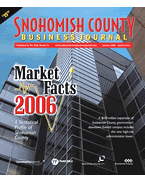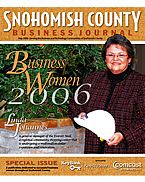 |
|
|
YOUR
COUNTY.
|
YOUR
BUSINESS JOURNAL.
|
Published March 2006
Four
tips to energize
2006 marketing effort
 Economic
forecasts predict a robust year ahead for the Puget Sound region. But
don’t depend on market growth alone to ensure that your current advertising
budget will do the job for your organization in 2006. Now is the time
to re-evaluate your marketing plans and determine how best to deploy your
advertising budget.
Economic
forecasts predict a robust year ahead for the Puget Sound region. But
don’t depend on market growth alone to ensure that your current advertising
budget will do the job for your organization in 2006. Now is the time
to re-evaluate your marketing plans and determine how best to deploy your
advertising budget.
The media world is in turmoil. Not only are consumers getting better at avoiding commercial messages, they’re using Internet tools to gather information as well as make their preferences known to an enormous audience. Word of mouth is now one of the most powerful forces in marketing — and shrewd marketers are finding new ways to harness it.
If your marketing plan fails to take this media revolution into account, your chances of succeeding are reduced. This year, the best way to stay ahead of your competition is to begin with a serious re-evaluation of your marketing strategy.
|
SCBJ welcomes columnist Fritsch In this issue of the business journal, we bring you a new marketing column by Bill Fritsch, president of Hydrogen Advertising in Seattle, a 30-year marketing and advertising veteran whose resume includes work with Walt Disney, the Sharp Hartwig advertising agency in Seattle and co-founding Christiansen & Fritsch. He grew that agency into Cf2GS, with capitalized billings of $62 million, a staff of 88 and offices in Seattle, Portland and San Francisco, with such clients as US Bank, Royal Caribbean International, Hewlett-Packard and WRQ. Today, as head of Hydrogen Advertising, whose client list includes The Everett Clinic, one of the largest local employers in Snohomish County, Fritsch writes on occasion for various business, marketing and advertising publications. We are pleased to have the opportunity to provide his provocative and insightful views on marketing and advertising to our readers. At the same time, we want to express our thanks to marketing writer Andrew Ballard, who has offered our readers excellent columns each month for the past five years, since February 2001, drawing on his experiences and expertise in marketing and business promotion. Since we like to change columnists periodically, to gain a variety of insights on various business topics, we also will be changing some of our other writers in coming months — as well as welcoming some new ones. We hope you enjoy the changes. — John Wolcott, SCBJ Editor |
Here are four tips to get your marketing efforts off to a great start in 2006.
- Begin anew. Most marketing plans have legacy programs that take on a life of their own. Often, they’re granted “sacred cow” status that precludes serious assessment of their effectiveness. “We have always used direct mail to tackle this market segment. And our president doesn’t like more expensive media.” This kind of attitude leaves little room for analysis and innovation, the keys to continued success. The fact is, every program should be re-examined annually. Financial marketers, for example, would be wise to scrutinize the money they’re allocating for direct mail in 2006. A recent study by the Direct Marketing Association revealed that response rates to financial direct mail are plummeting despite innovations in targeting and database. Why? America’s homes are buried in financial direct mail. With the growth of the do-not-call list, financial institutions have redirected telemarketing money into the mailbox; around 50 percent of their advertising dollars go into direct mail.
- View this year as the beginning of a many-year journey to success. No matter how large the budget, most organizations don’t have enough money to do as much as they’d like. Most marketing professionals want to do quality work, but they focus first on their limited means, and then do their best to handle only the hottest demands from within the company. As a result, there is little money for brand building, experimentation and innovation. Frankly, many budgets are simply too meager to fund the kind of quality work that distinguish a brand in the marketplace — and companies with inadequate resources can be doomed to take their place with the also-rans. Yet, a simple change in perspective can allow a less-affluent advertiser to accomplish more and look like a leader in the process. Rather than think about this year’s plan and budget as a discrete set of activities, consider that it is the beginning of a multi-year program. Rather than having a budget of $250,000 in 2006 for example, you actually have a three-year budget in excess of $750,000. With that higher level of resources what would you accomplish? And which activities are the most important to begin the journey well? These become this year’s projects. This thought process completely rearranges what is possible.
- Focus on the few things that have the power to move your marketplace. Ad-industry veteran Ron Christiansen often speaks of companies that try to pour “a thousand drops into a thousand buckets. The smaller the budget, the more things people want to do. And in the process, everything is rendered ineffective.” Advertising takes courage. And often that involves saying no to nonessential efforts that take the power out of an advertising budget. I have never seen a marketing plan that couldn’t be improved by taking marginal programs out of the plan and focusing more dollars on the programs that can affect real change for a company, especially when combined with a three-year perspective.
- Think big, spend small. Some marketers squeeze dollars out of their advertising by tightening down the budgets paid to their creative resources. Inadvertently, these marketers encourage small thinking that leads to marketplace blah. A much better way to save money is to devote more dollars to creative development of big ideas that can shake a complacent marketplace. Once big ideas are developed and approved, the effort should begin to find ways to implement these in extremely cost-effective ways. This should be part of the creative challenge given to agencies.
So, my advice is to review your 2006 plans, slaughter your sacred cows, focus your resources on programs that can energize your organization and make your agency an active part of driving big ideas in cost-effective ways. Even small budgets pack a punch under these circumstances.
Bill Fritsch, a longtime leader in the Puget Sound ad industry, is president of Hydrogen Advertising, www.hydrogenadvertising.com. Call him at 206-389-9500, Ext. 224, or send e-mail to bill@hydrogenadvertising.com.













